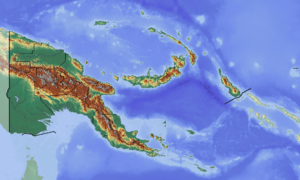Barygenys cheesmanae
Barygenys cheesmanae is a species of frogs in the family Microhylidae. It is endemic to eastern New Guinea and is only known from Mount Tafa in Central Province, Papua New Guinea.[1][2] The specific name cheesmanae honors Lucy Evelyn Cheesman, an English entomologist, explorer, curator at London Zoo,[3] and collector of the holotype.[4] Common name Cheesman's Papua frog has been coined for this species.[1][2][3]
| Barygenys cheesmanae | |
|---|---|
| Scientific classification | |
| Kingdom: | Animalia |
| Phylum: | Chordata |
| Class: | Amphibia |
| Order: | Anura |
| Family: | Microhylidae |
| Genus: | Barygenys |
| Species: | B. cheesmanae |
| Binomial name | |
| Barygenys cheesmanae Parker, 1936 | |
 | |
| Barygenys cheesmanae is only known from Mount Tafa in Papua New Guinea | |
Description
Barygenys cheesmanae grows to 40 mm (1.6 in) in snout–vent length. It has a globose body, a narrow head with pointed snout, and very short hind limbs. The snout bears three conspicuous vertical ridges. The tympanum is present but indistinct; a weakly developed supratympanic fold is present. The fingers are short, broad at the base, and tapering to narrowly rounded tips. The toe tips are rounded, without terminal grooves or dilations. No webbing is present. The dorsal groundcolor varies from brownish yellow to pale brown to deep red-brown. A number of more or less black spots are irregularly scattered on the dorsum. Some pink spots may also be present. The hind limbs are darker and may have some reddish color. The lower surfaces vary from dirty yellow to brown.[4]
Habitat and conservation
Barygenys cheesmanae is known from montane rainforest at elevations of 2,070–2,590 m (6,790–8,500 ft) above sea level. Its ecology is poorly known, but it is probably a secretive and terrestrial species;[1] the species describer noted this frog as living in holes in the ground. Males call throughout the day.[4] Development is presumably direct[1] (i.e, there is no free-living larval stage[5]). There are no known threats to this species that is considered to live in a remote area. It is not known to occur in any protected areas.[1]
References
- Richards, S. & Zweifel, R. (2004). "Barygenys cheesmanae". IUCN Red List of Threatened Species. 2004: e.T57705A11672696. doi:10.2305/IUCN.UK.2004.RLTS.T57705A11672696.en. Retrieved 6 May 2020.
- Frost, Darrel R. (2020). "Barygenys cheesmanae Parker, 1936". Amphibian Species of the World: an Online Reference. Version 6.1. American Museum of Natural History. doi:10.5531/db.vz.0001. Retrieved 6 May 2020.
- Beolens, Bo; Watkins, Michael & Grayson, Michael (2013). The Eponym Dictionary of Amphibians. Pelagic Publishing. p. 41. ISBN 978-1-907807-42-8.
- Zweifel, Richard George (1972). "A revision of the frogs of the subfamily Asterophryinae, family Microhylidae". Bulletin of the American Museum of Natural History. 148: 411–546.
- Vitt, Laurie J. & Caldwell, Janalee P. (2014). Herpetology: An Introductory Biology of Amphibians and Reptiles (4th ed.). Academic Press. p. 166.
